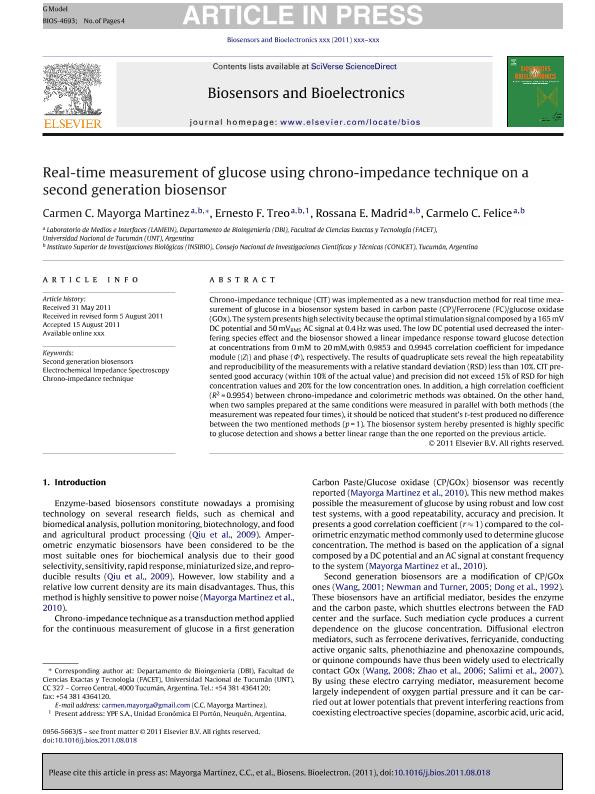Mostrar el registro sencillo del ítem
dc.contributor.author
Mayorga Martinez, Carmen Clotilde

dc.contributor.author
Treo, Ernesto Federico

dc.contributor.author
Madrid, Rossana Elena

dc.contributor.author
Felice, Carmelo Jose

dc.date.available
2018-10-01T21:28:33Z
dc.date.issued
2011-11
dc.identifier.citation
Mayorga Martinez, Carmen Clotilde; Treo, Ernesto Federico; Madrid, Rossana Elena; Felice, Carmelo Jose; Real-time measurement of glucose using chrono-impedance technique on a second generation biosensor; Elsevier Advanced Technology; Biosensors & Bioelectronics; 29; 1; 11-2011; 200-203
dc.identifier.issn
0956-5663
dc.identifier.uri
http://hdl.handle.net/11336/61460
dc.description.abstract
Chrono-impedance technique (CIT) was implemented as a new transduction method for real time measurement of glucose in a biosensor system based in carbon paste (CP)/Ferrocene (FC)/glucose oxidase (GOx). The system presents high selectivity because the optimal stimulation signal composed by a 165mV DC potential and 50mV RMS AC signal at 0.4Hz was used. The low DC potential used decreased the interfering species effect and the biosensor showed a linear impedance response toward glucose detection at concentrations from 0mM to 20mM,with 0.9853 and 0.9945 correlation coefficient for impedance module (|Z|) and phase (Φ), respectively. The results of quadruplicate sets reveal the high repeatability and reproducibility of the measurements with a relative standard deviation (RSD) less than 10%. CIT presented good accuracy (within 10% of the actual value) and precision did not exceed 15% of RSD for high concentration values and 20% for the low concentration ones. In addition, a high correlation coefficient (R 2=0.9954) between chrono-impedance and colorimetric methods was obtained. On the other hand, when two samples prepared at the same conditions were measured in parallel with both methods (the measurement was repeated four times), it should be noticed that student's t-test produced no difference between the two mentioned methods (p=1). The biosensor system hereby presented is highly specific to glucose detection and shows a better linear range than the one reported on the previous article.
dc.format
application/pdf
dc.language.iso
eng
dc.publisher
Elsevier Advanced Technology

dc.rights
info:eu-repo/semantics/openAccess
dc.rights.uri
https://creativecommons.org/licenses/by-nc-sa/2.5/ar/
dc.subject
Chrono-Impedance Technique
dc.subject
Electrochemical Impedance Spectroscopy
dc.subject
Second Generation Biosensors
dc.subject.classification
Biotecnología relacionada con la Salud

dc.subject.classification
Biotecnología de la Salud

dc.subject.classification
CIENCIAS MÉDICAS Y DE LA SALUD

dc.title
Real-time measurement of glucose using chrono-impedance technique on a second generation biosensor
dc.type
info:eu-repo/semantics/article
dc.type
info:ar-repo/semantics/artículo
dc.type
info:eu-repo/semantics/publishedVersion
dc.date.updated
2018-10-01T15:24:13Z
dc.journal.volume
29
dc.journal.number
1
dc.journal.pagination
200-203
dc.journal.pais
Países Bajos

dc.journal.ciudad
Amsterdam
dc.description.fil
Fil: Mayorga Martinez, Carmen Clotilde. Consejo Nacional de Investigaciones Científicas y Técnicas. Centro Científico Tecnológico Conicet - Tucumán. Instituto Superior de Investigaciones Biológicas. Universidad Nacional de Tucumán. Instituto Superior de Investigaciones Biológicas; Argentina. Universidad Nacional de Tucumán. Facultad de Ciencias Exactas y Tecnología. Departamento de Bioingeniería. Laboratorio de Medios e Interfases; Argentina
dc.description.fil
Fil: Treo, Ernesto Federico. Consejo Nacional de Investigaciones Científicas y Técnicas. Centro Científico Tecnológico Conicet - Tucumán. Instituto Superior de Investigaciones Biológicas. Universidad Nacional de Tucumán. Instituto Superior de Investigaciones Biológicas; Argentina. Universidad Nacional de Tucumán. Facultad de Ciencias Exactas y Tecnología. Departamento de Bioingeniería. Laboratorio de Medios e Interfases; Argentina
dc.description.fil
Fil: Madrid, Rossana Elena. Universidad Nacional de Tucumán. Facultad de Ciencias Exactas y Tecnología. Departamento de Bioingeniería. Laboratorio de Medios e Interfases; Argentina. Consejo Nacional de Investigaciones Científicas y Técnicas. Centro Científico Tecnológico Conicet - Tucumán. Instituto Superior de Investigaciones Biológicas. Universidad Nacional de Tucumán. Instituto Superior de Investigaciones Biológicas; Argentina
dc.description.fil
Fil: Felice, Carmelo Jose. Universidad Nacional de Tucumán. Facultad de Ciencias Exactas y Tecnología. Departamento de Bioingeniería. Laboratorio de Medios e Interfases; Argentina. Consejo Nacional de Investigaciones Científicas y Técnicas. Centro Científico Tecnológico Conicet - Tucumán. Instituto Superior de Investigaciones Biológicas. Universidad Nacional de Tucumán. Instituto Superior de Investigaciones Biológicas; Argentina
dc.journal.title
Biosensors & Bioelectronics

dc.relation.alternativeid
info:eu-repo/semantics/altIdentifier/url/http://www.sciencedirect.com/science/article/pii/S0956566311005422
dc.relation.alternativeid
info:eu-repo/semantics/altIdentifier/doi/https://dx.doi.org/10.1016/j.bios.2011.08.018
Archivos asociados
